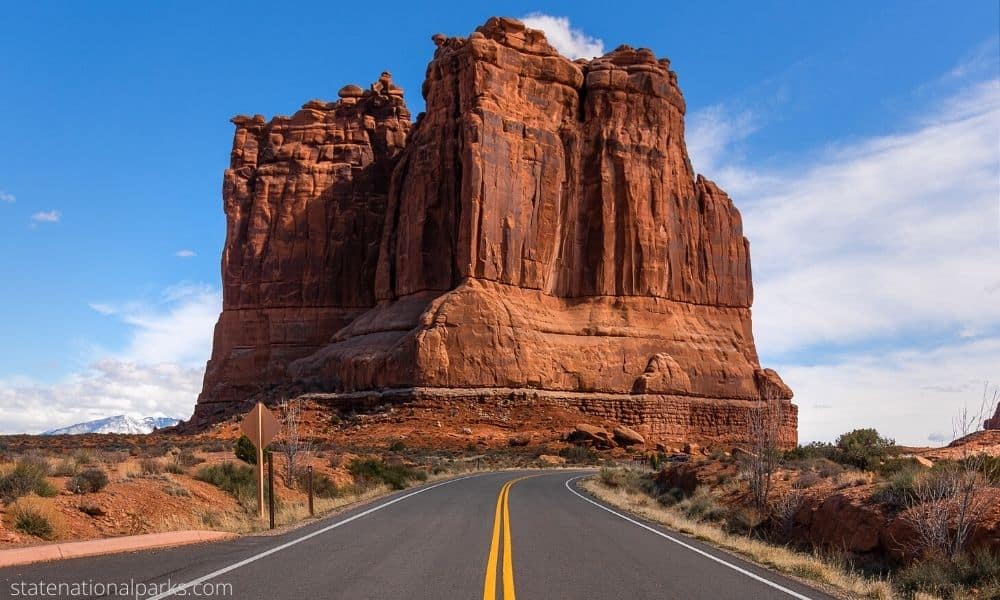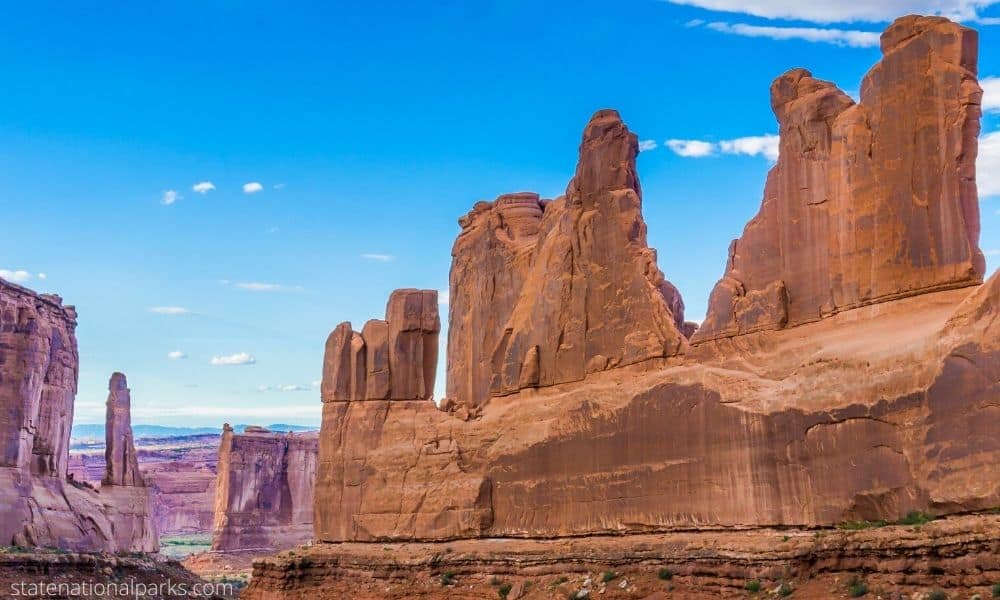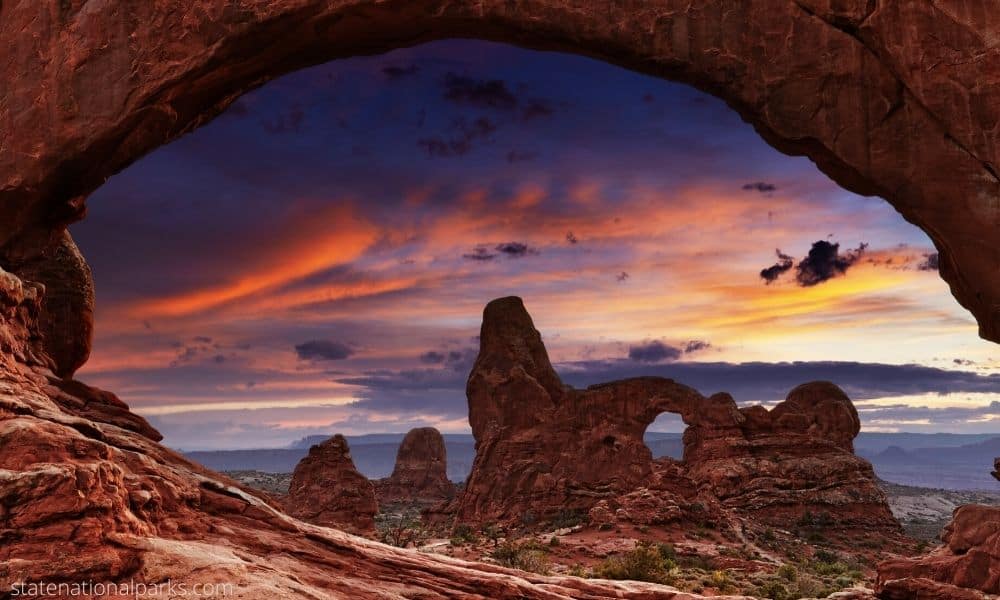 Arches National Park is without a doubt one of the nicest Utah national parks, which means plenty of cars and other people passing by. But if you get there in the winter, you can probably expect quite a few fewer people! Also, if you’re going hiking there in peak time, then hopefully you’ll bring loads of food (minimum 2 liters in the car), sunscreen, water, and a map/ compass. There are a few places you can get really wet if the weather gets to be bad, so make sure to have those items with you too. If you’re not bringing a lot of food supplies, I’d suggest staying at one of the Utah winter hotels where you won’t have to pay the super-cheap hotel rates to eat in.
Arches National Park is without a doubt one of the nicest Utah national parks, which means plenty of cars and other people passing by. But if you get there in the winter, you can probably expect quite a few fewer people! Also, if you’re going hiking there in peak time, then hopefully you’ll bring loads of food (minimum 2 liters in the car), sunscreen, water, and a map/ compass. There are a few places you can get really wet if the weather gets to be bad, so make sure to have those items with you too. If you’re not bringing a lot of food supplies, I’d suggest staying at one of the Utah winter hotels where you won’t have to pay the super-cheap hotel rates to eat in.
The main thing to know about these impressive arches national park hikes is that they start off easy and should only take about an hour or so. The first two miles of the trail are typically packed with wildlife; mainly deer and elk. Go up to the first canyon across from where the highway starts to go south, at mile two you will see some Jeep tracks.
Head back to the parking lot and continue on foot, passing several viewpoints on your way up to another plateau. This one has a great view of the Wasatch Mountains, but it also has a rather fiery furnace running underneath. If you’re staying at one of the Utah winter hotels, it’s pretty much a free-fire to cook up some marshmallows or other fun winter treats. You can catch the glimpse of a few wild donkeys running past on the way up to the top of the trails.
Now for the longest part of the hike, the steep climb up to the “arch”. It’s actually more of a loop, since there is a gradual decline in grade along the way; it’s not a straight path. At about the third turn, make a right turn and you’ll be at the start of a nice trail with wonderful views of Wasatch Mountains. Keep hiking on this path as it makes its way down to the trademark arch, which rises up out of the slick rock at the end of the arches.
Here’s an easy way to get started on one of these arches national park hikes. As you pass through a beautiful forest area, look for some old tree trunks sitting on the ground. They are a great place to for a picnic. As you are approaching the arches, look for a small stream with some frogs in it. This is an easy way to get your first taste of what this national park has to offer.
Overall, if you have never done any arches national park hikes then you definitely need to take this route to the end of the trail because it’s a wonderful experience. This trail is one day long and offers a beautiful view of the gorgeous mountains surrounding the park. I highly recommend it.
Arches National Park is located in the high desert of eastern Utah and experiences a semi-arid climate with hot summers and cold winters. Here are some general weather patterns you can expect in the park:
- Temperatures: Summers in Arches National Park are hot, with daytime highs often in the 90s to low 100s Fahrenheit (32-38°C). Nights can be cooler, with temperatures dropping into the 50s to 60s Fahrenheit (10-16°C). Winters are cold, with daytime highs ranging from the 30s to 50s Fahrenheit (-1 to 10°C), and nighttime lows often dropping below freezing.
- Precipitation: Arches National Park receives an average of around 10 inches (25 cm) of precipitation per year, with the majority falling during the late summer and early fall. Thunderstorms are common during this time and can bring sudden, heavy downpours.
- Wind: Wind can be a factor in Arches National Park, particularly in the spring and fall. Wind gusts can be strong, especially in the open areas of the park, and can create blowing sand and dust.
If you plan to visit Arches National Park, it’s important to come prepared for the weather conditions. During the summer months, bring light-colored and loose-fitting clothing, sunscreen, and plenty of water. In the winter, bring warm layers and be prepared for potentially icy and snowy conditions. Be aware of the potential for sudden thunderstorms during the late summer and early fall and seek shelter if necessary. It’s also important to be prepared for strong winds and blowing sand during your visit.
Related posts:
Arches National Park, located in eastern Utah, is known for its spectacular rock formations, but it is also home to a variety of wildlife species. Visitors to the park have the opportunity to observe a range of mammals, birds, reptile...
Camping at Arches National Park is hands down the best and easiest way to experience Arches National Park for yourself! You simply begin/end your hiking day at the park! You no longer need to drive the forty minute plus back to Moab (depending on the...
Arches National Park, located in eastern Utah, is renowned for its stunning natural rock formations and towering arches that attract visitors from all over the world. Among the most notable of these arches is the Skyline Arch, which is one ...
One of the best ways to explore the beauty of the arches is through camping. There are several options for campsites in Arches National Park. If you don't have a park pass, camping within the park is an excellent way to save money on entrance fees. Y...
Arches National Park in southeastern Utah is home to some of the most iconic geological formations in the United States. The park is known for its many natural arches, including one of the most famous arches in the world, the Delicate Arch....
Arches National Park, located in southeastern Utah, is famous for its stunning red rock formations and natural arches. One of the most famous and impressive arches in the park is Landscape Arch, which is located in the Devil's Garden area o...